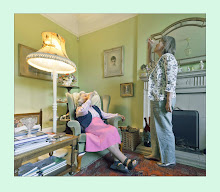Tate Britain does not often show photography but the Tate as a whole has made a committment to showing photography, recognising it as an art form. However, one wondered what had made them choose Edweard Muybridge, whose work could be shown in a science museum since his photographic studies of locomotion in both animals and humans, led to a better scientific understanding of motion as a whole.
Some of Muybridge's early work reveals landscapes photographed with great attention to detail which are given wider impact by an artistic sensitivity towards composition. Using a large camera with the wet-plate collodion process (he continued with this method until the 1880's) that produced sizeable contact prints, he made images that predate and resemble those that Ansel Adams was to make in the following century for Muybridge worked a great deal in the Yosemite National Park.
Muybridge's photographs from the 1870's of San Francisco contain among them detailed 360 degree panoramas of the city before it was destroyed in the 1906 earthquake and fire. They also show the area before the building of the Golden Gate Bridge which opened in 1933.
However, Muybridge is best known for his studies of motion, made with a line of cameras that were fired one after the other by the subject passing and setting off the shutter by a trip wire. The old age question of whether that had been discussed as far back as the ancients of Greece, of whether a galloping horse ever left the ground completely or always had a foot on the ground, was finally solved; a horse when galloping can be entirely off the ground at a given moment since Muybridge was able to photograph this and show the different movements that led up to and followed it.
Although Muybridge did not actually invent cinematography, he certainly anticipated it as he did many other things. One might point to the case of O.J.Simpson who many consider escaped justice after killing his wife and her lover for Muybridge on discovering his wife had an affair, went out and shot the offending man, a theatre critic, and was eventually acquitted by a jury.
Yet, Muybridge also influenced many artists which is perhaps the main reason his work is being shown at Tate Britain. Degas is one artist who copied directly from his work, with one of his bronze sculpture's being of an image of a horse called Daisy and named 640 after a negative that had recorded it. Muybridge was aware of just how little artists really new about motion and so was able to show them not just a new way of conveying it but of a much more realistic one too though many may not have fully realised this at the time.
The surrealists were also affected by Muybridge's studies as were more recent artists such as Francis Bacon. Yet his work also influenced many photographers.
If Art can be said to make us see the world differently then Muybridge is a great artist and a realsitic one too.
Subscribe to:
Post Comments (Atom)

No comments:
Post a Comment